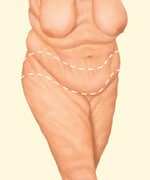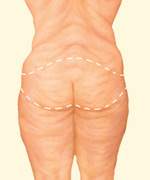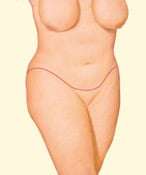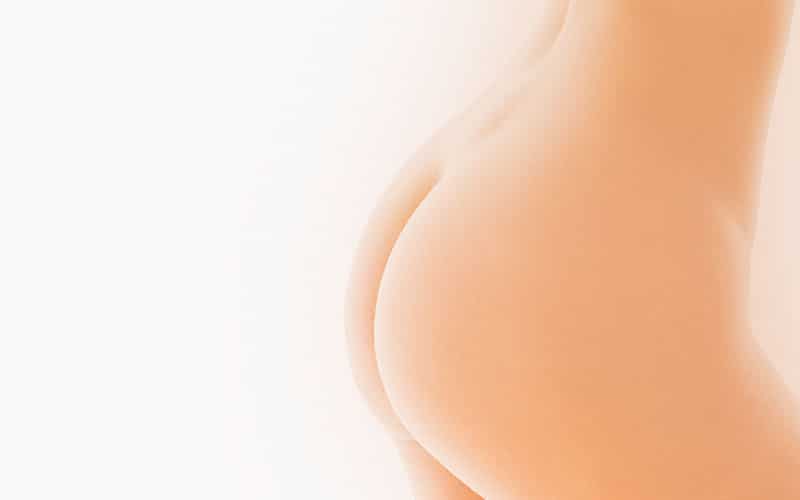Abdominoplasty
Abdominoplasty, whether partial or complete, produces excellent results for patients with weakened abdominal muscles or excess skin. And in most cases, the results are long lasting, if you follow a balanced diet and exercise regularly.
If you’re realistic in your expectations and prepared for the consequences of a permanent scar and a lengthy recovery period, abdominoplasty may be just the answer for you.
Terminology Notes
Video
Abdominoplasty, known more commonly as a “tummy tuck,” is a major surgical procedure to remove excess skin and fat from the middle and lower abdomen and to tighten the muscles of the abdominal wall. The procedure can dramatically reduce the appearance of a protruding abdomen. But bear in mind, it does produce a permanent scar, which, depending on the extent of the original problem and the surgery required to correct it, can extend from hip to hip.
Candidates for Tummy Tuck
The best candidates for abdominoplasty are men or women who are in relatively good shape but are bothered by a large fat deposit or loose abdominal skin that won’t respond to diet or exercise. The surgery is particularly helpful to women who, through multiple pregnancies, have stretched their abdominal muscles and skin beyond the point where they can return to normal. Loss of skin elasticity in older patients, which frequently occurs with slight obesity, can also be improved.
Patients who intend to lose a lot of weight should postpone the surgery. Also, women who plan future pregnancies should wait, as vertical muscles in the abdomen that are tightened during surgery can separate again during pregnancy. If you have scarring from previous abdominal surgery, your doctor may recommend against abdominoplasty or may caution you that scars could be unusually prominent.
Abdominoplasty can enhance your appearance and your self-confidence, but it won’t necessarily change your looks to match your ideal, or cause other people to treat you differently. Before you decide to have surgery, think carefully about your expectations and discuss them with your surgeon.
If you’re considering abdominoplasty, this will give you a basic understanding of the procedure-when it can help, how it’s performed, and what results you can expect. It can’t answer all of your questions, since a lot depends on the individual patient and the surgeon. Please ask your surgeon about anything you don’t understand.
Most commonly, the surgeon will make a long incision from hipbone to hipbone, ,just above the pubic area. A second incision is made to free the navel from surrounding tissue. With partial abdominoplasty, the incision is much shorter and the navel may not be moved, although it may be pulled into an unnatural shape as the skin is tightened and stitched.
Next, the surgeon separates the skin from the abdominal wall all the way up to your ribs and lifts a large skin flap to reveal the vertical muscles in your abdomen. These muscles are tightened by pulling them close together and stitching them into their new position. This provides a firmer abdominal wall and narrows the waistline.
The skin flap is then stretched down and the extra skin is removed. A new hole is cut for your navel, which is then stitched in place. Finally, the incisions will be stitched, dressings will be applied, and a temporary tube may be inserted to drain excess fluid from the surgical site.
In partial abdominoplasty, the skin is separated only between the incision line and the navel. This skin flap is stretched down, the excess is removed, and the flap is stitched back into place.




Pre-Operative Consultation
In your initial consultation, your surgeon will evaluate your health, determine the extent of fat deposits in your abdominal region, and carefully assess your skin tone. Be sure to tell your surgeon if you smoke, and if you’re taking any medications, vitamins, or other drugs.
Be frank in discussing your expectations with your surgeon. He or she should be equally frank with you, describing your alternatives and the risks and limitations of each.
If, for example, your fat deposits are limited to the area below the navel, you may require a less complex procedure called a partial abdominoplasty, also know as a mini-tummy tuck, which can often be performed on an outpatient basis. You may, on the other hand, benefit more from partial or complete abdominoplasty done in conjunction with liposuction to remove fat deposits from the hips, for a better body contour. Or maybe liposuction alone would create the best result.
In any case, your surgeon should work with you to recommend the procedure that is right for you and will come closest to producing the desired body contour.
During the consultation, your surgeon should also explain the anesthesia he or she will use, the type of facility where the surgery will be performed, and the costs involved. In most cases, health insurance policies do not cover the cost of abdominoplasty, but you should check your policy to be sure.
Operation and Recovery Logistics
Many surgeons perform both partial and complete abdominoplasties in an outpatient surgical center or an office-based facility. Others prefer the hospital, where their patients can stay for several days.
Your surgeon will give you specific instructions on how to prepare for surgery, including guidelines on eating and drinking, smoking, and taking or avoiding certain vitamins, and medications.
If you smoke, plan to quit at least one to two weeks before your surgery and not to resume for at least two weeks after your surgery. Avoid overexposure to the sun before surgery, especially to your abdomen, and do not go on a stringent diet, as both can inhibit your ability to heal. If you develop a cold or infection of any kind, your surgery will probably be postponed.
Whether your surgery is done on an outpatient or inpatient basis, you should arrange for someone to drive you home after your surgery, and to help you out for a day or two after you leave the hospital, if needed.
SURGERY DURATION
Complete abdominoplasty usually takes two to five hours, depending on the extent of work required. Partial abdominoplasty may take an hour or two.
ANESTHESIA
Your doctor may select general anesthesia, so you’ll sleep through the operation. Other surgeons use local anesthesia, combined with a sedative to make you drowsy. You’ll be awake but relaxed, and your abdominal region will be insensitive to pain. (However, you may feel some tugging or occasional discomfort.)
Post-Operative Care
For the first few days, your abdomen will probably be swollen and you’re likely to feel some pain and discomfort which can be controlled by medication. Depending on the extent of the surgery, you may be released within a few hours or you may have to remain hospitalized for two to three days.
Your doctor will give you instructions for showering and changing your dressings. And though you may not be able to stand straight at first, you should start walking as soon as possible.
Surface stitches will be removed in five to seven days, and deeper sutures, with ends that protrude through the skin, will come out in two to three weeks. The dressing on your incision may be replaced by a support garment.
It may take you weeks or months to feel like your old self again. If you start out in top physical condition with strong abdominal muscles, recovery from abdominoplasty will be much faster. Some people return to work after two weeks, while others take three or four weeks to rest and recuperate.
Exercise will help you heal better. Even people who have never exercised before should begin an exercise program to reduce swelling, lower the chance of blood clots, and tone muscles. Vigorous exercise, however, should be avoided until you can do it comfortably.
Your scars may actually appear to worsen during the first three to six months as they heal, but this is normal. Expect it to take nine months to a year before your scars flatten out and lighten in color. While they’ll never disappear completely, abdominal scars will not show under most clothing, even under bathing suits.
Risks and Challenges
Thousands of abdominoplasties are performed successfully each year. When done by a qualified plastic surgeon who is trained in body contouring, the results are generally quite positive. Nevertheless, there are always risks associated with surgery and specific complications associated with this procedure.
Post-operative complications such as infection and blood clots are rare, but can occur. Infection can be treated with drainage and antibiotics, but will prolong your hospital stay. You can minimize the risk of blood clots by moving around as soon after the surgery as possible.
Poor healing, which results in conspicuous scars, may necessitate a second operation. Smokers should be advised to stop, as smoking may increase the risk of complications and delay healing.
You can reduce your risk of complications by closely following your surgeon’s instructions before and after the surgery, especially with regard to when and how you should resume physical activity.
FAQs
1. WHAT WILL AN ABDOMINOPLASTY DO FOR ME?
An abdominoplasty (tummy tuck) will remove excess skin, excess fat(through liposuction and direct surgical excision) and tighten the underlying abdominal muscles. During the surgery, hernias can often times get repaired and the appearance of the umbilicus (belly button)will be improved.
2. THE SCAR SEEMS LIKE IT IS QUITE LONG. WHERE IS IT LOCATED AND CAN YOU MAKE IT SHORTER?
The length of the scar reflects the extent of skin laxity present on a patient. Well-meaning attempts to shorten these scars usually result in patient disappointment, since residual excess loose tissue will still be noticeable over the thighs and hips, especially when sitting. Currently, the most effective way of getting rid of loose skin and fat is surgical removal and, like it or not, this involves scars of some sort. Of course, a plastic surgeon with an aesthetic sensibility will make every effort to keep the scars short and low enough to be hidden in current bikini styles.
3. HOW LONG WILL IT TAKE FOR MY SCAR TO FADE?
This depends upon your inherent biochemistry (determined by your genetic structure) and the manner with which the surgeon closes your incision. I close my abdominoplasties in multiple layers and make sure the the strength of the closure lies in the deeper tissues and not at the skin edge (remember, there is a good deal of tension in pulling two edges of skin together in a tummy tuck similar to the tension exerted on a seam line when a 170 lb woman gets into a size 2 dress!) . This concept translates into better scars especially when meticulous stitching is also thrown into the mix. The average abdominoplasty scar takes about 6-12 months to fade.
4. WHAT HAPPENS IF IT DOESN’T?
It will to some extent. However, if certain areas of the scar remain discoloured (pink or brown) and /or raised, then we can utilize modern laser therapy, silicone sheeting and judicious use of modified cortisone injections to treat the remaining problems. As a last resort, a small scar revision may be necessary.
5. WILL A TUMMY TUCK GET RID OF MY STRETCH MARKS?
To the extent that the surgeon is able to safely incorporate them within the area of actual skin and fat to be removed, then yes. The remaining stretch marks will be improved in appearance because they will be stretched tightly and moved inferiorly towards the pubic region. Generally, the stretch marks that extend above your umbilicus will not be removed, only improved.
6. I HEAR IT CAN SOMETIMES BE QUITE PAINFUL. IS IT?
To put this in perspective, a Cesarian section is generally rated an 8 out of 10 in terms of pain (10 being worst). A tummy tuck rates on average a 5 – 6 out of 10. However, with progress comes good news. Pain pumps are a welcome new addition to the field of Plastic Surgery. It allows us to strategically deliver controlled amounts of non-narcotic pain medicine directly to the operative site through minute catheters. Patients report their pain after a pain pump-assisted abdominoplasty as a low 2 out of 10. That is progress!
7. DO YOU USE DRAINS?
Yes. Otherwise, the fluid that results from the inflamed tissue after surgery will accumulate behind the abdomial skin and fat requiring more invasive procedures to remove it. Most drains are removed when they drain less than 30 cc in a 24-hour period; generally, this point is reached between 3-5 days after the procedure.
8. IT IS 3 WEEKS AFTER THE SURGERY AND I THOUGHT I WAS GOING TO BE FLATTER. WHAT CAN BE DONE?
Patience! it is absolutely normal for patients to feel bloated and still fat in the postoperative period. Rest assured that this represents normal postoperative swelling and retained “water weight’ and will diminish after about 2-3 months.
9. I AM VERY NUMB ALONG MY LOWER STOMACH. WHAT IS WRONG?
There is nothing wrong. It is absolutely normal to have numbness and even stiffness around the lower portion of your abdomen after an abdominoplasty. This will dissipate with time.
10. WHEN CAN I GO BACK IN THE SUN AND EXERCISE AGAIN?
If you feel “up to it”, you can return to mild exercise (stationary bicycle, treadmill, light weights, etc.) after 4 weeks, using an appropriate abdominal-binder or back-brace for added support and safety. However, it is not recommended to return to any form of abdominal exercise for 3 months. Avoid sun till all the bruising is gone. Don’t tan the scar till the pinkness is gone.



